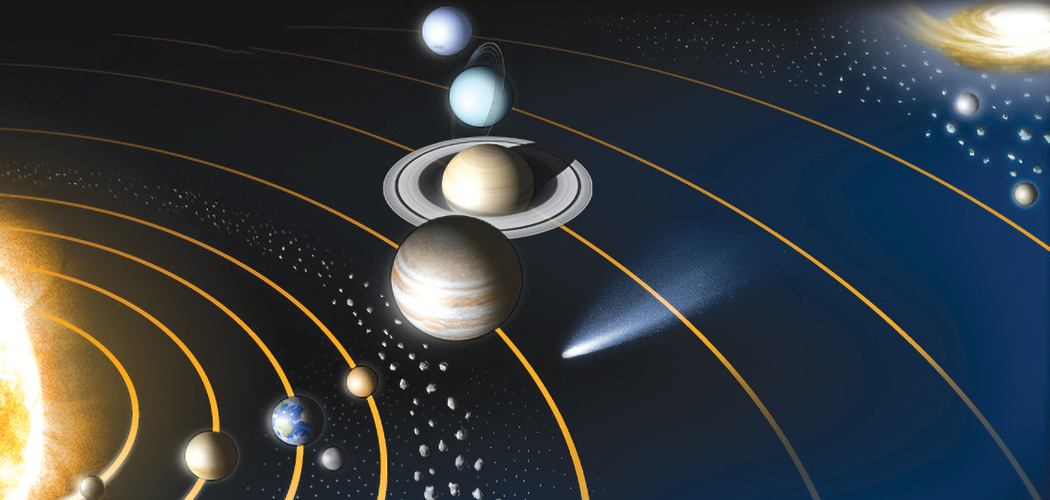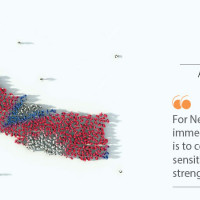- Tuesday, 2 December 2025
Planets In Captivating Constellations
Dr. Rishi Shah
The night skies of this month would present confounding cornucopia of planets residing in captivating constellations along with many other strange stars and extraordinary entities located all over the heavens.
The elusive planet Mercury could be admired for few hours in south-eastern sky at dawn before being lost in solar glare after mid-month. It would be cavorting with the stars that form the eastern section of tea-pot resembling constellation Sagittarius (archer). Mercury would reach its greatest western elongation from the Sun on 30 January. It would be the best time to marvel Mercury since it would hover at its highest point above the horizon in the eastern morning sky just before sunrise.
Planet Venus could be perceived briefly in south-western sky after sundown. It would be frolicking with the stars that dwell in the constellation Capricornus (sea goat). Venus could be applauded below Mercury. The red planet Mars would be entering the eastern sky after sunset. It would be climbing aloft in southern sky late at night. It would then be sliding towards north-western horizon during wee hours after midnight.
It would be prancing playfully with the shimmering stars of constellation Taurus (bull). The alluring Aldebaran (Rohini) would be scintillating superbly below Mars. Mighty planet Jupiter could be sighted shortly but confidently after sunset in south-eastern sky. It could be ascertained among the stars glistening in the eastern part of the constellation Aquarius (water bearer). The ringed planet Saturn would be tersely visible in south-eastern sky after night-begin among the stars that would be coruscating congenially in the eastern corner of triangle-shaped constellation Capricornus. It would be out of view after middle of the month.
Far-flung planet Uranus could be glimpsed in south-eastern sky after nightfall. It would be ascending the southern sky late at night. It would sink slowly towards western horizon by mid-night. Uranus could be spotted in the southern sparse cosmic expanse in constellation Aries (ram) to the west of Mars. The iconic constellation Cetus (whale) would be sprawling below Uranus. The distant planet Neptune could be discerned in south-western sky at dusk for few hours among the stars gleaming on the eastern flank of constellation Aquarius.
Two amazing asteroids 2 Pallas and 6 Hebe would be at so-called opposition on 16 January and 26 January 2023 respectively. The Sun and earth would lie in a straight line with the earth in the middle and stay on the same side with the asteroids.
They would be closest to earth (termed perigee) then. They could be followed as fulgently fleeting dot of light in south-eastern sky at evening twilight. They would be soaring in southern sky till midnight and eventually be inaccessible above south-western horizon very late at night. They would be merrily mingling with stars of charming constellations Canis Major (greater dog) and Cancer (crab).
Baffling bright binary star Sirius (Lubdhak) would be resting relaxed in Canis Major. It would be dramatically 8.6 light-years away. The full moon would befall on 06 January. Its popular moniker has been designated as the wolf full moon, because during this time of year hungry wolf packs would be howling outside human settlements. The month-long Shree Swosthani Puja would commence on this day with veneration. The new moon would transpire on 21 January. Shree Saraswoti Puja would be celebrated respectfully on 26 January.
Quadrantid meteor shower could be relished during its peak activity from the night of the 03 till the morning of the 04 January 2023 with display of prolific flashes of shooting stars. Quadrantid meteor shower would generally be agile from 12 December to 12 January. Over this period, there would be comfortable chance of seeing Quadrantid meteors whenever the shower's radiant would be above the eastern horizon.
For us the shower could be savored with satisfaction after midnight. The shower would perhaps produce its peculiar performance before dawn. At its climax, the shower would be expected to exhibit nominal rate of 40 to 120 meteors per hour under ideal conditions of dark sky with no moon, when the radiant would be high in the sky. The excellent opportunity for watching Quadrantids and enjoying the sparkling show could be during an hour of true darkness after moonset. The bright nearly full moon would shine almost all night.
The moon would be only two days away from full phase at the shower's maximum and be relaxing in constellation Taurus. It would be interfering significantly during Quadrantids observation throughout the night.
The moon would block out most of the fainter meteors. However the avid onlookers could still catch patiently fulgurating meteors streaking from the kite-mimicking constellation Bootes (herdsman). This chief object that would spawn the Quadrantids has been acrimoniously acclaimed to be now dormant and extinct asteroid known as 2003 EH1, which had been confirmed critically in 2003. NASA’s Lowell Observatory Near-Earth-Object Search (LONEOS) based near Flagstaff in Arizona had identified this atypical asteroid 2003 EH1 in 2003. It would require simply 5.5 years for revolving around the Sun. Its most immediate point to the Sun (dubbed perihelion) would be merely 1.2 AU.
Meteor showers would originate when the earth would pass through streams of debris left behind in the wake of comets and asteroids. Over time, these grit-like dregs would distribute themselves along the parent body's track. Meteors would be obviously observable whenever these pieces would collide with the earth's atmosphere, typically burning up at an altitude of around 70 to 100 kilometers with speeds of whooping 70 kilometers per second.
The radiant of the Quadrantids would make an approximate right angle with the famed constellation Ursa Major alias Big Dipper (greater bear) and the resplendent red giant star Arcturus (Swati) that would be barely 36.7 light-years away. It has been an aging star basically seven billion years old indicating questionably the same mass as the Sun, but has expanded eerily to 25 times its size and become very luminous.
Its diameter would evidently endorse to be apparently 35 million kilometers. The traditional name Arcturus meaning guardian of the bear had been Latinized from the ancient Greek. Most meteor showers obtain their sobriquets from the constellations from which they emanate.
Even though the constellation Quadrans Muralis (mural quadrant) would no longer exist Quadrantids are being still recognized currently by the defunct constellation. French astronomer Jerome Lalande had created this constellation in 1795. This now-obsolete constellation had been sandwiched between the constellation Bootes and circumpolar constellation Draco (dragon). In 1922 International Astronomical Union (IAU) had established the list of the 88 modern constellations without including Quadrans Muralis.
During the earth's annual orbit around the Sun it would arrive at its most embracing place to the Sun at the distance measuring quaintly 0.9833 AU or 147.099 million kilometers. The earth's nearest and furthest gap from the Sun would vary by around three per cent over the course of the year because its trail would be exiguously oval-alike, roughly mirroring an ellipse. However in practice, this variation could be comparatively rather slight, because our planet’s path around the Sun has been deemed almost circular.
Thus, earth’s tightest tryst or rendezvous to the Sun during its revolution around it would occur oddly on the same day every year in manner like coinciding on 04 January in 2023 during winter in Northern Hemisphere.
This day would mark the moment when the Sun would appear larger in the sky than at any other time of year and the earth would allegedly receive the most solar radiation from it as well. The relatively puny three per cent differences in the earth's span from the Sun would be just meagerly noticeable.
The changes in our weather between the summer and winter have been triggered predominantly by the tilt manifesting to fairly 23.5 degrees of the rotation earth's axis, rather than by any alteration in earth’s length from the Sun. The position of the Sun at perihelion would be in constellation Sagittarius. One astronomical unit (AU) has been defined as the average distance between the Sun and earth and would express to circa 150 million kilometers.
(Dr. Shah is an academician at NAST and patron of NASO)

















